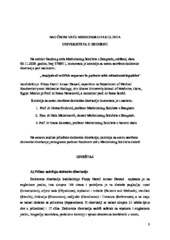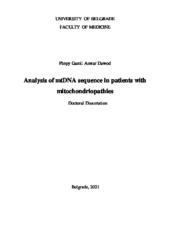Приказ основних података о дисертацији
Analysis of mtDNA sequence in patients with mitochondriopathies
Analiza sekvence mitohondrijske DNK kod pacijenata sa mitohondriopatijama
| dc.contributor.advisor | Novaković, Ivana | |
| dc.contributor.other | Jančić, Jasna | |
| dc.contributor.other | Drulović, Jelena | |
| dc.contributor.other | Maksimović, Nela | |
| dc.contributor.other | Kavečan, Ivana | |
| dc.creator | Dawod, Phepy Gamal Amvar | |
| dc.date.accessioned | 2022-01-21T15:33:02Z | |
| dc.date.available | 2022-01-21T15:33:02Z | |
| dc.date.issued | 2021-09-30 | |
| dc.identifier.uri | http://eteze.bg.ac.rs/application/showtheses?thesesId=8473 | |
| dc.identifier.uri | https://fedorabg.bg.ac.rs/fedora/get/o:24872/bdef:Content/download | |
| dc.identifier.uri | http://vbs.rs/scripts/cobiss?command=DISPLAY&base=70036&RID=53930505 | |
| dc.identifier.uri | https://nardus.mpn.gov.rs/handle/123456789/18906 | |
| dc.description.abstract | to deficiencies of the energy production in mitochondria. MCPs can be expressed in many tissues, especially those with higher metabolic demands so they affect most commonly nervous system and muscles. MCPs are characterized by clinical heterogeneity presented by varioaus clinical phenotypes, occur at any age and.could be mild or severe. Besides nervous system and muscles, eye, heart, liver, kidney, bone marrow and other organs could be involved. The main cause of MCPs are genetic changes but interaction with environmental factors plays a role also. Mitochondrial function is controlled by genes located in both nuclear and mitochondrial genome. Mitochondrial genome is represented by maternally inherited mitochondrial DNA (mtDNA), which is considered as a genetic hotspot for MCPs. Molecules of mtDNA show 10–20 times higher mutational rate compared to nuclear genetic material, and could be affected by point mutations, larger deletions or even deplecion, all leading to MCPs. Estimated prevalence of MCPs is 1 in 8.000 to 20.000. Some examples of the disorders caused by pathogenic mtDNA mutations are: Leber hereditary optic neuropathy (LHON), mitochondrial encephalomyopathy with lactic acidosis and stroke-like episodes (MELAS), maternally inherited Leigh syndrome (LS), neuropathy, ataxia and retinitis pigmentosa (NARP), myoclonic epilepsy with ragged-red fibers (MERRF), etc. Genetics background of the pathogenic mtDNA mutations, represented by secondary mutations and mitochondrial haplogroups, affects penetrance and expressivitiy of MCPs. Geographic and/or ethnic specificity of this background emphasizes its role. Aim: The main aim of thic study was determination and characterisation of primary and secondary mutations of mtDNA in patients clinically diagnosed with MCPs. The majority of cases had LHON, but MELAS and other mitochondriopathies were included also. It was planned to detect the well-known LHON mutations m.3460G>A, m.11778G>A, and m.14484T>C, major MELAS mutation m.3243A>G and other mutations specific for MCPs in Serbian patients. Another objective was establishement of the specific genetic background with determination of mtDNA haplogroups of the respondents and construction of the corresponding phylogenetic tree. Finally, the aim was correlation between genotype and phenotype in MCPs patients. Material and methods: This study included total number of eleven unrelated Serbian subjects – probands diagnosed with MCPs and four their asymptomatic relatives. Probands were diagnosed in the Clinic for Neurology and Psychiatry for Children and Youth and Clinic of Neurology, Clinical Centre of Serbia, Belgrade. In all respondents full clinical examination was performed. Demographic data, habits and risk factors, past personal and familial history were evaluated. Family history for maternal relatives was clarified in detail. All molecular genetic analyses of mtDNA were performed in the Laboratory for genetic and molecular diagnostics of neurological diseases at the Clinic for Neurology, Clinical Centre of Serbia. The detection of mtDNA mutations was performed by direct Sanger sequencing of whole mitochondrial genome. Revised Cambridge Reference Sequence of human mtDNA was used for comparision. Prediction of mtDNA mutations‘ pathogenicity was done by in silico analysis using available softwares. MITOMASTER analysis was used for the determination of haplogroups and characterization of pathogenic variants. The phylogenetic tree was constructed according to mtDNA tree Build 17 nomenclature... | sr |
| dc.description.abstract | Mitohondriopatije (MHP) su heterogena grupa genetiĉki uslovljenih oboljenja koja nastaju zbog poremećaja u proizvodnji energije u mitohondrijama. Ovi poremećaji se mogu izraziti u brojnim tkivima, posebno u onim sa većim metaboliĉkim zahtevima, pa je stoga u sklopu MHP ĉesta zahvaćenost nervnog i mińićnog sistema. Pomenuta heterogenost MHP ispoljava se razliĉitim kliniĉkim fenotipovima, bolesti se javljaju u bilo kojoj dobi života, mogu biti blage ili teńke i mogu da ukljuĉuju jedan ili vińe organa. Pored skeletnih mińića i nervnog sistema mogu biti zahvaćeni oko, srce, jetra, bubreg, końtana srž i drugo. U nastanku MHP glavnu ulogu imaju genetiĉki faktori, koji deluju u sadejstvu sa faktorima okoline. Funkcija mitohondrija je kontrolisana genima smeńtenim u jedarnom genomu, ali i genima koji se nalaze u sastavu mitohondrijske DNK (mtDNK). MtDNK se nasleĊuje matroklino tj. od majke, i ima 10–20 puta veću stopu mutacija u odnosu na DNK u jedru. U mtDNK se mogu detektovati razliĉite promene, kao ńto su taĉkaste mutacije, veće delecije ili ĉak deplecije molekula, ńto ima za posledicu MHP ĉija je procenjena ukupna prevalenca 1 na 8.000 do 20.000. Primeri MHP koja nastaju usled patogenih mutacija u mtDNK su: Leberova hereditarna optiĉka neuropatija (LHON), mitohondrijska encefalomiopatija sa laktiĉkom acidozom i epizodama sliĉnim moždanom udaru (MELAS), Leigh-ov sindrom (LS) nasledan po majci, sindrom neuropatije, ataksije i pigmentne retinopatije (NARP), miokloniĉna epilepsija sa iskrzanim crvenim vlaknima (MERRF) i druge mitohondrijske bolesti. Prilikom prouĉavanja penetrantnosti i ekspresivnosti patogenih mutacija kod MHP, treba imati na umu ulogu sekundarnih mutacija kao i razliĉitih haplotipova mtDNK ĉoveka, koji mogu biti karakteristiĉni za odreĊeni geografski region ili za etniĉku grupu. Cilj: Studija je sprovedena sa ciljem analize primarnih i sekundarnih mutacija mtDNK kod pacijenata iz Srbije sa kliniĉkom dijagnozom MHP. Većina sluĉajeva obuhvatala je Leberovu hereditarnu optiĉku neuropatiju (LHON), a bili su ukljuĉeni i pacijeni sa sumnjom na MELAS i druge mitohondriopatije. Kod LHON planirana je detekcija dobro poznatih primarnih mutacija: m.3460G> A, m.11778G> A i m.14484T> C, kao i sekundarnih i intermedijarnih promena u mtDNK, zatim kod MELAS detekcija glavne mutacije m.3243A> G, kao i analiza drugih patogenih mutacija specifiĉnih za MHP. TakoĊe, cilj je bilo utvrĊivanje mtDNK haplotipa kod nosilaca mutacije, sa konstrukcijom filogenetskog stabla. Poslednji cilj istraživanja je bila korelacija genotipa sa fenotipskim karekteristikama ispitanika. Materijal i metode: Ovom studijom obuhvaćeno je ukupno jedanaest nesrodnih ispitanika - probanada sa sumnjom na MHP, kao i ĉetvoro asimptomatskih srodnika obolelih. Dijagnoze su postavljene na Klinici za neurologiju i psihijatriju za decu i omladinu i Klinici za neurologiju Kliniĉkog centra Srbije, u Beogradu. Kod svih ispitanika obavljen je detaljan neurolońki i neuro-oftalmolońki pregled. Prikupljeni su demografski podaci, podaci o životnim navikama i faktorima rizika, uzeta je detaljna liĉna i porodiĉna anmenza. Posebno podrobno su uzeti podaci o porodiĉnoj istoriji ńto se tiĉe srodnika sa majĉine strane. Sve molekularno genetiĉke analize mtDNK izvrńene su u Laboratoriji za genetsku i molekularnu dijagnostiku neurolońkih bolesti na Klinici za neurologiju Kliniĉkog centra Srbije, Beograd. Prisustvo mutacija u mtDNK je analizirano direktnim sekvenciranjem po Sangeru ĉitavog mitohondrijskog genoma, a za poreĊenje je korińćena revidirana Cambridge referentna sekvenca humane mtDNK. Potencijalna patogenost mutacija mtDNK proverena je in silico pomoću dostupnih softvera za predikciju.Za odreĊivanje haplogrupa mtDNK i karakterizaciju patogenih varijanti korińćen je MITOMASTER. Filogenetsko stablo ispitanika je konstruisano prema mtDNK stablu Build 17 nomenklature... | en |
| dc.format | application/pdf | |
| dc.language | sr | |
| dc.publisher | Универзитет у Београду, Медицински факултет | sr |
| dc.rights | openAccess | en |
| dc.rights.uri | https://creativecommons.org/licenses/by-nc-nd/4.0/ | |
| dc.source | Универзитет у Београду | sr |
| dc.subject | Leber's hereditary optic neuropathy | sr |
| dc.subject | Leberova hereditarna optiĉka neuropatija | en |
| dc.subject | MELAS | en |
| dc.subject | Leighov sindrom | en |
| dc.subject | mtDNK | en |
| dc.subject | mutacije | en |
| dc.subject | haplogrupe | en |
| dc.subject | MELAS | sr |
| dc.subject | Leigh syndrome | sr |
| dc.subject | mtDNA | sr |
| dc.subject | mutations | sr |
| dc.subject | haplogroups | sr |
| dc.title | Analysis of mtDNA sequence in patients with mitochondriopathies | sr |
| dc.title.alternative | Analiza sekvence mitohondrijske DNK kod pacijenata sa mitohondriopatijama | en |
| dc.type | doctoralThesis | |
| dc.rights.license | BY-NC-ND | |
| dcterms.abstract | Новаковић, Ивана; Друловић, Јелена; Кавечан, Ивана; Јанчић, Јасна; Максимовић, Нела; Даwод, Пхепy Гамал Aмвар; | |
| dc.identifier.fulltext | http://nardus.mpn.gov.rs/bitstream/id/141997/Referat.pdf | |
| dc.identifier.fulltext | http://nardus.mpn.gov.rs/bitstream/id/141998/Disertacija_12046.pdf | |
| dc.identifier.rcub | https://hdl.handle.net/21.15107/rcub_nardus_18906 |



